Location: French Harbour, Roatan, Honduras
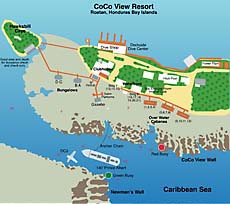 Overall: CoCo View is a resort that primarily caters to scuba divers. It is a small community of bungalows, cabanas and buildings on a secluded peninsula and not a traditional luxury resort with fancy restaurants and clubs. CoCo View has a very tropical feel, with flocks of Hummingbirds darting around, palm trees and other lush tropical greenery everywhere, and no cars at all. All of the bungalows and cabanas are directly on the water. Diving is sensational, with two walls and a wreck right off the resort beach and dozens of coral reef/wall dive sites reachable via dive boat within minutes.
Overall: CoCo View is a resort that primarily caters to scuba divers. It is a small community of bungalows, cabanas and buildings on a secluded peninsula and not a traditional luxury resort with fancy restaurants and clubs. CoCo View has a very tropical feel, with flocks of Hummingbirds darting around, palm trees and other lush tropical greenery everywhere, and no cars at all. All of the bungalows and cabanas are directly on the water. Diving is sensational, with two walls and a wreck right off the resort beach and dozens of coral reef/wall dive sites reachable via dive boat within minutes.
Getting there: Getting to Roatan is fairly easy. It may be a peninsula off an island off mainland Honduras, but it's just a two and a half hour flight from Houston or Atlanta to Roatan island. And not in a small turboprop, but in a full-size plane.
Arrival/customs: On your flight you fill out customs documents. Upon arrival, depending on the crowd and timing of flight arrivals, it can take quite a bit to make it past immigration, which includes electronic fingerprint scanning of all ten fingers and a picture. Depending on your airline, exiting the plane may be in front and rear, so sitting in the back may get you to immigration first!
If your luggage is marked with one of the hot pink CoCo View tags that you receive with your package, CoCo View staff will gather it together. Once through immigration, you also go through customs carry-on check, which is very fast. A CoCo View staff person meets and greets you and shows you to the airconditioned CoCo View bus.
When you leave, you're generally dropped off with plenty of time to spare. Depending on the time of day, you may have to wait for the airline staff to show up. You can use the time to get your paper work done with immigrations. There is no more exit tax to be paid at the airport (it's now included in your plane ticket). Your carry-on will be checked and then re-checked. And re-checked again.
Getting to the resort: The ride from the airport to CoCo View is about 20 minutes in the CoCo View bus. You see a colorful mix of American-style shopping strips, more modest local stores, corrugated steel covered huts, and driveways to mansions and resorts. You can ask the driver to stop at a supermarket if you want to pick up snacks and such.
The ride ends at a large boathouse from where you're ferried to the actual resort, just a short way away across a still mangrove-rimmed lagoon, and yet so far from civilization. Once at the resort, you get a brief introduction from a staff person who also hands out forms and the usual disclaimers and waivers to sign. The office will want to see your diving C-cards.
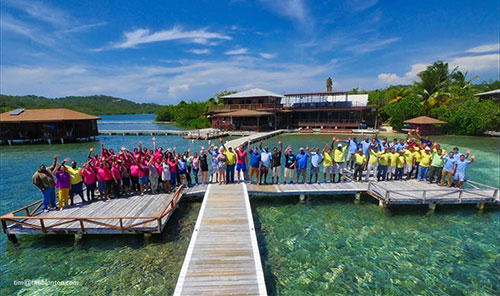
General: CoCo View is a "self-contained" resort. It is secluded and totally secure, and unless you schedule a trip via boat and van/taxi, you do not leave the resort. I am not the partying type and was quite content with staying at the resort, especially since the clubhouse is a very cozy hangout and I was usually busy uploading my underwater pictures and just generally being too pooped from diving. The resort does organize several events every week, and so you never get bored. Below you can see some of the guestroom bungalows and cabanas on water. Yes, they have incredible sunsets.


Rooms: There are different styles of rooms at CoCo View, with a total of 28 generously sized guest rooms in all. They consist of 4 over-the-water bungalow rooms, 12 over-the-water cabana rooms, and 12 oceanfront rooms. In addition, there are the Mango Suite, the CoCo Casa and the CoCo Villa. A few privately owned beach houses right next to CoCo View may also be available.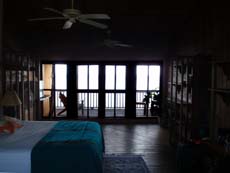
During our August/September 2019 trip we stayed at Cabanas C12 in the all-wood cabana structures sitting on stilts on the water. The room was large, had two fairly comfortable (except the pillows) queen beds, several fans, and US-type 110 Volt electrical outlets. There are plenty of lights.
Water pressure was very good and there was plenty of hot water. Each room has a 5-gallon jug of filtered water for drinking or whatever else you want to use it for (the resort says the tap water is fine, but the recommendation is not to use it for drinking). There were enough towels. Beach/boat towels can be picked up and exchanged in front of the office free of charge. 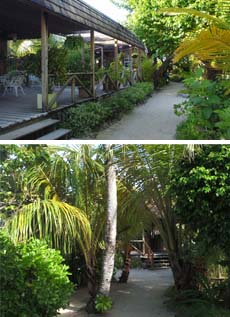
There was no hair dryer (which we certainly didn't need anyway), and there aren't the usual elaborate little toiletry kits, so bring your own shampoo. Our room did have a bottle of liquid soap, and also a large bar of soap. The room had a coffee maker which I used every day. The local coffee supplied is strong and delicious. A nice size covered balcony faces, and is on, the sea; a great place to have your morning coffee or enjoy a starry night in the comfortable hammock.
The air conditioner in our room was a modern split unit with remote control and worked very well. That's a blessing when it's hot and muggy.
Clubhouse/Dining Room: The Clubhouse building serves as dining room, bar, hangout and, upstairs, conference/class room and hangout with a large flatscreen TV. It's a tropical looking rustic all-wooden structure that also has a ping-pong table and dancing area, games, as well as a library/computer area. The Clubhouse used to be the focal point of the resort, but since WiFi became available in the guest rooms, it's become quieter in there and at the bar.
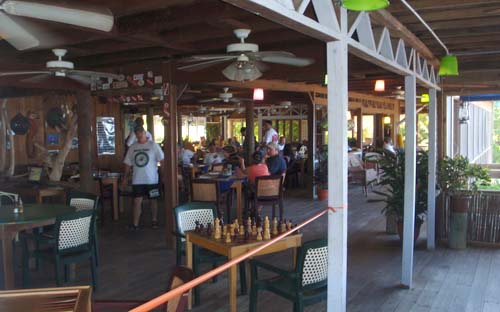
Food: Full packages include breakfast, lunch and dinner. All meals are buffet-style. There is always a nice diversity so that there is something for everyone. Food quality and taste on our August/September 2018 stay was very good, even better than on any of our prior visits over the past ten years. On our most recent stay, August/September 2019, quality was down some. There is no soda machine, but you can help yourself to unlimited lemonade, water, coffee and ice tea (and lots of ice). If you want soda, beer or drinks with dinner, get them at the bar (inquire about prices as they keep going up). Make sure you get there on time or else the staff may have already closed the buffet.
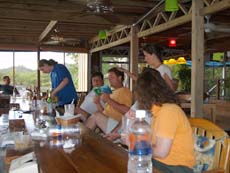 Bar: The tropical-style bar is part of the diningroom/clubhouse. Beer, wine and alcoholic drinks are available. Try CoCoView's special resort drink, the Monkey LaLa. Sodas all come in old-fashioned glass bottles. There's Fanta, Coca Cola and Coca Cola Light (different from Diet Coke), as well as "Tropical" grape and other sodas. The bar runs a tab. No bar tips as those are included in the summary tip paid at the end (see below).
Bar: The tropical-style bar is part of the diningroom/clubhouse. Beer, wine and alcoholic drinks are available. Try CoCoView's special resort drink, the Monkey LaLa. Sodas all come in old-fashioned glass bottles. There's Fanta, Coca Cola and Coca Cola Light (different from Diet Coke), as well as "Tropical" grape and other sodas. The bar runs a tab. No bar tips as those are included in the summary tip paid at the end (see below).
Dive boats: CoCo View has a fleet of four or five sturdy regular dive boats, plus the larger and speedy Easy Diver boat. You sit along the sides, your tanks behind you, with a cubby below the seat. There is an area to soak cameras. Entry into the water is either at the back of the boat or on either side. To get back in, you either use the two ladders at the back or re-enter through a shaft in the bottom of the boat. The boat has cold water and our crew usually offered sliced fresh pineapple or melon. After the morning and afternoon dive to designated dive sites, the boats will drop you off at dive sites close to shore (usually Newman's Wall in the morning, CoCo View Wall in the afternoons). You can ask them to drop you off where you want to go.

Air: You get your own tanks or staff will automatically bring them to your locker. The boat crew will put your BC/tank on the boat for you (unless you signal not to with a wooden token). 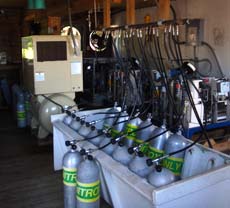 Air is included in the price of the dive package. If you want Nitrox (which almost everyone used during our August/September 2019 stay), it's US$8 per tank or US$125 per week per diver. Nitrox tanks must be tested for Oxygen percentage by divers, with the information entered into a logbook that's on the table in each boat's locker area. Each locker area has an oxygen sensor. Nitrox divers are also responsible for putting a sticker with Nitrox info on their tanks. You can leave your dive gear in a locker/gearing-up area on the dock.
Air is included in the price of the dive package. If you want Nitrox (which almost everyone used during our August/September 2019 stay), it's US$8 per tank or US$125 per week per diver. Nitrox tanks must be tested for Oxygen percentage by divers, with the information entered into a logbook that's on the table in each boat's locker area. Each locker area has an oxygen sensor. Nitrox divers are also responsible for putting a sticker with Nitrox info on their tanks. You can leave your dive gear in a locker/gearing-up area on the dock.
Weights: The resort has lead weights that you check out when you get there. You determine how much you need. There are plenty and they are available in pound increments.
Diving: CoCo View offers a nearly unbeatable combination of reef and wall diving. The location of the resort is unique. There are two walls (the CoCo View Wall and the Newman Wall) within easy reach from the shore. CoCo View Wall is within 140 yards from beach entry right in front of the CoCo View clubhouse where the water is almost always totally calm. It's shallow, too, and you can walk out to a small platform. From there it's between four and ten feet deep until the sandy bottom descends into a deeper channel between the two walls. The wreck of the Prince Albert, a 140 foot long former tanker, lies in maybe 65 feet of water and, a short distance away, so do the remnants of a DC3 airplane. Where else can you go dive a major wreck and a historic airplane right from the beach?

The CoCo View dive schedule consist of two boat trips every day. The boats usually leave at 8:30AM for a dive site that's anywhere from five minutes to half an hour away. 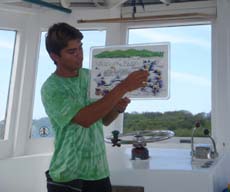 You never go too far from the shore as the reefs and walls are close. Each dive boat has a captain and a dive master. The dive master explains each dive, points out interesting things during the dive, and makes sure no one gets lost. Dives are usually an hour. For the second dive of a boat trip, the captain will drop you off at one of the walls close to the resort, or over the wreck. In the afternoons, the boat leaves at 2:00PM, again doing one dive site and a drop-off dive.
You never go too far from the shore as the reefs and walls are close. Each dive boat has a captain and a dive master. The dive master explains each dive, points out interesting things during the dive, and makes sure no one gets lost. Dives are usually an hour. For the second dive of a boat trip, the captain will drop you off at one of the walls close to the resort, or over the wreck. In the afternoons, the boat leaves at 2:00PM, again doing one dive site and a drop-off dive.
Most dives consist of a drop off to a reef top at depths between 25 and 45 feet and then excursions along walls that can drop down from dozens to many hundreds of feet. Visibility varies from very good to a bit murky, and it can change quickly depending on where you go. Along the walls it is usually fair to very good, and on the reef tops as well. In the channel between the two walls, where the wreck of the Prince Albert lays, visibility is usually less and changes almost on an hourly basis. Most often, CoCo View sites have between 50 and 80 feet visibility.
For beach night dives, the protocol at CoCo View is that a flashing strobe must be attached high above the bottom on the "front yard" buoy mooring chain. The first diver who goes out must take the strobe and attach it. Each subsequent diver signs for and takes a numbered tag that must be clipped onto the chain. That way everyone knows divers are out there. Upon return, the last diver retrieves the strobe and brings it back in.
Shark dive: You can sign up for a shark dive organized by a couple of Italian divemasters who run Waihuka Diving Adventures. The dive site they boat their daring customers to is called "Cara a Cara" — Spanish for Face-to-Face. You go down a line to about 70 feet where you stand or sit against a cliff. Shark feed operations use chum buckets full of stuff that sharks like and the local sharks know the routine. Once the dinner bell is rung, Caribbean Reef Sharks appear in a hurry and do get into the feeding frenzy you see in TV documentaries. However, they have no interest whatsoever in the divers, just the food in the chum bucket. Divers are allowed to circle around the whole scene. Once the chum is gone, the sharks leave. The whole thing is recorded on video and participants can buy a DVD. On our August/September 2018 trip, the shark dives were cancelled because there were no sharks. On our August/September 2019 trip, the sharks were back.
Fish and other sea life: This is diving in Caribbean waters on a shallow reef system and along dramatic vertical walls that can drop down anywhere from a few dozen feet to the next ledge or several hundred feet. It is a macro photographer's dream. You will see a lot of small fish — jaw fish, damsels, blennies, butterfly fish, chromis or hamlets. Somewhat larger are the angel fish, parrot fish, groupers and many more. You may also encounter the occasional octopus, sea horse, barracuda, turtle, scorpion fish and spiny lobster. There are schools of spade fish, jacks and sometimes, right off CoCo View resort, squid. You generally won't see many pelagics, though it always pays to keep your eyes open when you're swimming along a wall and peruse the blue water (once we even saw a whaleshark).
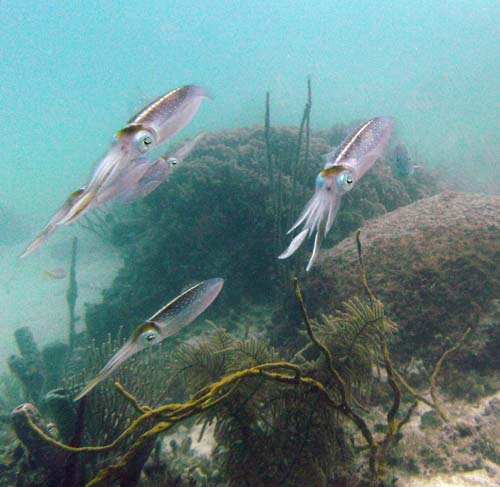
Dolphins and other extra activities: You can book a trip to go see dolphins (dive, snorkel, do an encounter), zip-line through the tropical forest, take an island tour, or go shopping. We took the Eco Tour Friday afternoon and very highly recommend it. There used to be an old seaplane to book rides on, but is no longer around.
Facilities/amenities:
- The Dockside Dive Shop is a PADI 5-star facility. It has a good variety of whatever one might need. The shop runs a tab for your room. The tab must be paid the day you depart, separately from the bill.
- There is Tim Blanton Productions, a shop for photography and video where you can get advice, supplies, rent camera equipment, and sign up for underwater photography classes.
- There is a weight/exercise room that has the best air conditioning in all of the resort. If you ever get hot, go to the exercise room to cool off.
- CoCo View has a small, centrally located shop adjacent to the office. It has a little bit of everything, from snacks and drinks (including some alcohol) to a nice cross section of mementos and souvenirs of all kinds. Some represent the arts of the islands and the prices are often lower than what one would pay from one of the visiting vendors.
Electricity: CoCo View gets its electricity from the island's grid and has backup generators. Electricity may go out at times, but it never presented a problem for us. Else, no brownouts or glitches of any kind.
Office: The office is centrally located and a good place to stop by because it has great air-conditioning. It's very informal and they have answers for everything and also advice. Everyone speaks English.
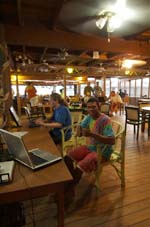 Computers/Internet: The resort has a number of wireless Access Points for guest internet access. A public access computer is located in the Club House. Wi-Fi coverage remains marginal, and Internet access slows down or becomes unavailable during times of heavy usage.
Computers/Internet: The resort has a number of wireless Access Points for guest internet access. A public access computer is located in the Club House. Wi-Fi coverage remains marginal, and Internet access slows down or becomes unavailable during times of heavy usage.
Cellphones: US cellphones don't work unless you've signed up for a special plan with your US provider. There is an island cellphone system, but I wasn't able to figure out what it supports. Email and texting, therefore, are via WiFi within the proximity of the wireless Access Points. We had no problems doing Facebook video calls.
BBQs: The resort used to do at least one lunch and one dinner BBQ-style on a small island with a bar structure and seating under trees at the tip of the CoCoView resort peninsula that's connected via walkways over water. There were no BBQs during our August/September 2019 visit, presumably because of the no-see-ums.
Security: The resort is secluded and can only be reach via boat. There is good lighting and security patrols the resort at night. It is, and feels, safe at all times. Each room has a small wooden lockbox for valuables. Rooms have old-style keys that you can either take with you on the boat or drop off at the office. We usually left the key in our open locker at the dock or simply left the room unlocked (yes, it feels that secure, even in 2019).
Vendors: Most days one or more vendors come to CoCoView and exhibit their arts and crafts in the area outside the dining room/clubhouse. Most of it is jewelry and smaller items made by local artisans including black coral items, decorated and painted wooden boxes, embroidery, etc. Most speak passable English. Payment is in US dollars and some accept credit cards. Prices are generally reasonable, but it pays to negotiate a deal. Keep a degree of skepticism so as not to overpay.
Cost: CoCo View differentiates between High Season (Mid January to mid August 10) and Value Season (Mid August to mid January). In August/September 2019, Cabana C12 cost us US$1,289 plus $245 hotel tax per week per diver. That included the very cool cabana room, all meals, and all diving (including air; nitrox is extra). Pricing has been creeping up over the past decade, and after taxes, tips, extra events and nitrox a stay at CoCo View is no longer inexpensive, but still more than worth it.
Tips: The resort recommends a 10-15% tip based on guests' cost of staying at CoCoView (before tax). So if the room/meals/diving total per diver is US$1,300, the suggested tip per diver per week is about US$130-195. You can pick up tip envelopes in the office for tips. No one sees how much of a tip you leave or who it is from. The money in the "general" envelope is being divided among all staff except the dive master and the boat captain. Those you tip separately. The suggestion is US$10 per diving day per person each for the captain and the dive master. So if you dive for six days that adds $120 per diver. Tips are usually paid in bills, but you can also charge gratuities.
Bottom Line: CoCo View is a delightfully unique diver's resort on the Honduran island of Roatan with 28 guest rooms in cabanas, bungalows (on the water) and beachside buildings. It is secluded and rustic, and has just the right combination of modern amenities and tropical charm. It has its own dive shop, five comfortable dive boats, store, and recreational facilities, but no conventional restaurants or clubs. Shore diving includes two walls and a large wreck, and there are dozens of coral reef/wall dive sites reachable within minutes via dive boat. Staff is friendly and competent, and the buffet-style food is good and plentiful. CoCo View boasts a very high number of returning guests, and we can see why.
For bookings/rates/info, see CoCo View Resort or Roatan Charter, Inc.








